skip to main |
skip to sidebar
Events of Saturday 26th April 2014
Click on any picture below for an uncropped image.
I spent Friday night in the Guest Room at Dr. Hla Tun’s house in Yangon. In a ‘Western style’ bed I started to catch up on sleep but still had to get up at 04:45 on Saturday because the Doctor and I were flying to Nyaung Oo to get to the Bagan Clinic. The Doctor’s charming wife had specially prepared oatmeal for my breakfast (my intolerance to even mildly spicy food is becoming well-known).
Around 05:20, I think, we set off by car, with the Doctor driving (together with his son, presumably to return the car after we’d left). At the Domestic Terminal, we were quickly checked-in for our flight by small turbo-prop to Nyaung Oo. I didn’t spot a single computer but the system usually works smoothly (albeit with a lot of manual checking and note-writing). Since this is the hot season, I was quite surprised to see that a lot of our passengers were European or Japanese tourists together with their guides. A few minutes later, we were shepherded to a waiting bus for a transfer of only a few yards to our waiting aircraft. Deparure time was 07:20 but, as has happened before, we were airborne before 07:10. The flight took around 75 minutes, in which time the friendly cabin crew had distributed daily newspapers, a pre-packed sandwich breakfast and hot and cold drinks.
Once landed, we disembarked, leaving passengers who were destined for Mandalay and Heho on board. No carousel, no belts, but the checked baggage very quickly arrived.
The Bagan Monastery ‘People Carrier’ was waiting to take us to the clinic. On the way, we paused at a tea shop in the town for the inevitable Sweet Tea before continuing past various 1000-year old temples to our destination.
On our arrival, the elderly Head Monk was waiting to greet us. The Clinic is on Monastic land and the active support of the Head Monk is essential.
When I first visited Bagan in 2008, there was no clinic in the dusty monastery compound. I became involved in the vision of the Head Monk and Doctor Hla Tun to provide a Free Medical Clinic for the people of this rural area. The original clinic building opened for business in 2011 and I attended the official opening ceremony on 30th October 2011 (Opening of the Bagan Medical Clinic). I'd certainly not realised the scale of demand which would be unleashed and there are a series of posts (Medical Support in Burma) showing just how many patients arrive on clinic days, sometimes travelling huge distances to seek affordable health care.
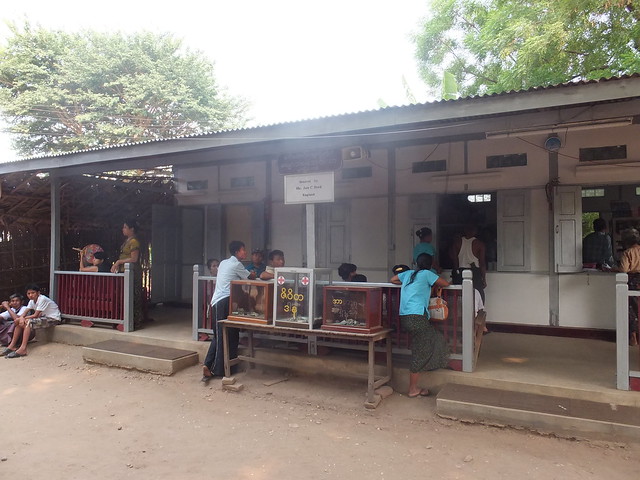 The original Clinic Building, formally opened on 30th October 2011, remains in use for consultations and dispensing medication.
The original Clinic Building, formally opened on 30th October 2011, remains in use for consultations and dispensing medication.
As the clinic became better known, local and overseas donors have provided further support and I was impressed to see the New Clinic Building which has been built a few yards away from the first building. This building was brought into use in February 2014 as a temporary Physiotherapy Unit since the majority of patients attending can benefit from physiotherapy.
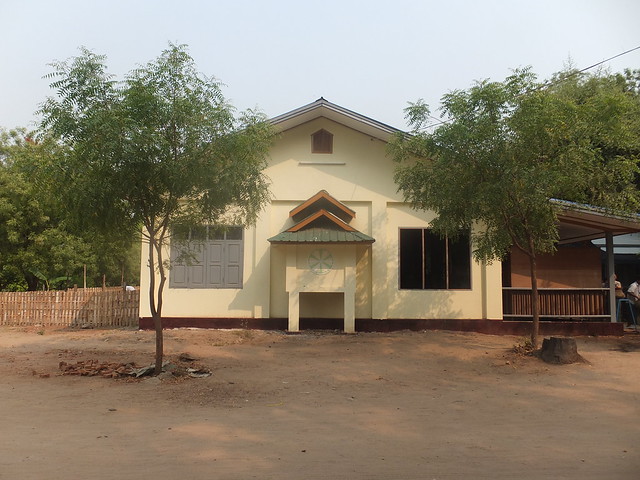 The New Clinic Building.
The New Clinic Building.
A Permanent Physiotherapy Unit, donated by a United Kingdom Travel Company and their clients, is currently being constructed.
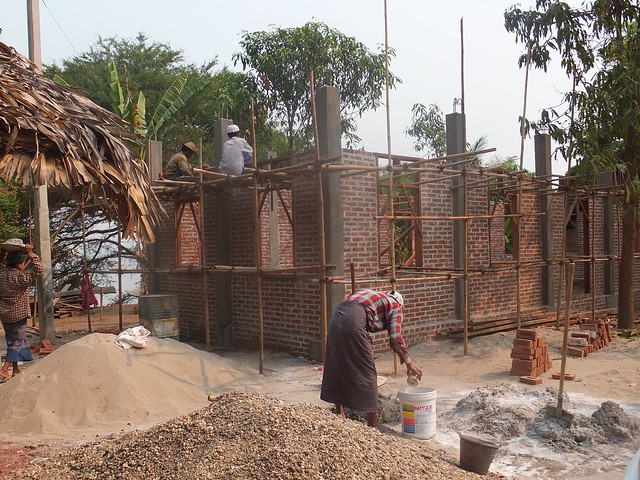 Builders at work on the new Physiotherapy Unit.
Builders at work on the new Physiotherapy Unit.
On Saturdays, a free lunch is prepared by the monastery and distributed to waiting patients.
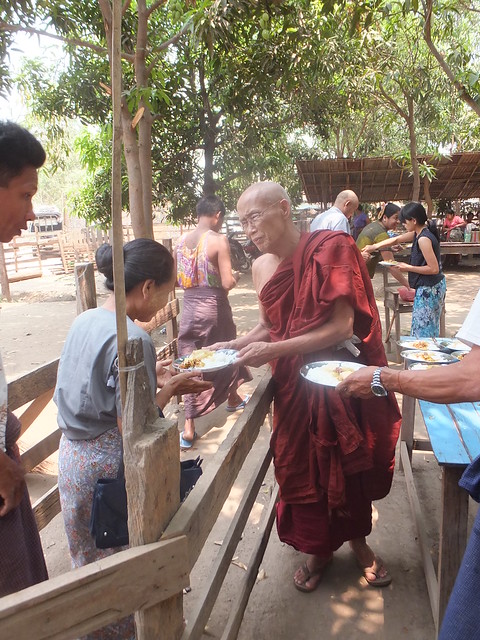
The Head Monk distributing free lunch to waiting patients.
Having taken plenty of pictures of the event, I said I'd walk back to my hotel and try to return when Dr. Hla Tun took his lunch at around two o'clock.
However, it was 42 degrees Celsius outside and by the time I'd arrived at my hotel, I was fit for nothing but resting, so I abandoned the idea of visiting the Doctor during his lunch. I knew that the Doctor normally took an evening meal in the Monastery about ten o'clock in the evening. I arrived back at the clinic around 9.30 p.m. when the Doctor was just breaking-off for food.
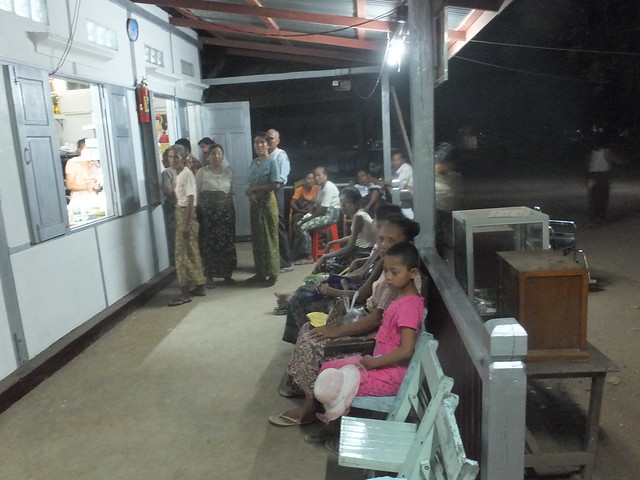 9.30 p.m. and now much quieter, but there are still patients waiting to be seen by a doctor.
9.30 p.m. and now much quieter, but there are still patients waiting to be seen by a doctor.
Doctor Hla Tun said he would then continue to work until about 11.30 p.m. to deal with the remaining 15 waiting patients but I'm afraid I left him to it and slowly made my way back to the Aye Yar Resort and bed.
My Pictures
Bagan Medical Clinic (My visit, April 2014).
Aye Yar River Resort, Bagan.
More
Next Post describing this trip.
All my posts on Medical Support in Burma.
[Revised 17-May-2014, 20-May-2014]
Events of Friday 25th April 2014
Click on any picture below for an uncropped image.
Although I’d slept a fair bit of the way back from Mawlamyine, the coach seats were really designed for a smaller, oriental frame. This, combined with a fairly intensive few days meant that I was not at my best when we disembarked in Yangon in the early morning.
Once back at Doctor Hla Tun's house, I managed a couple more hours sleep in the guest room before the Doctor took me to Yangon Central station. The Doctor knew of my interest in Myanmar Railways and he had kindly arranged for me to visit Yangon Central Signal Box to confirm what I'd previously written (Railway Signalling in Burma - Part 6: Signal Boxes with Electrical Interlocking). I spent a happy hour or so watching the complex moves around the station.
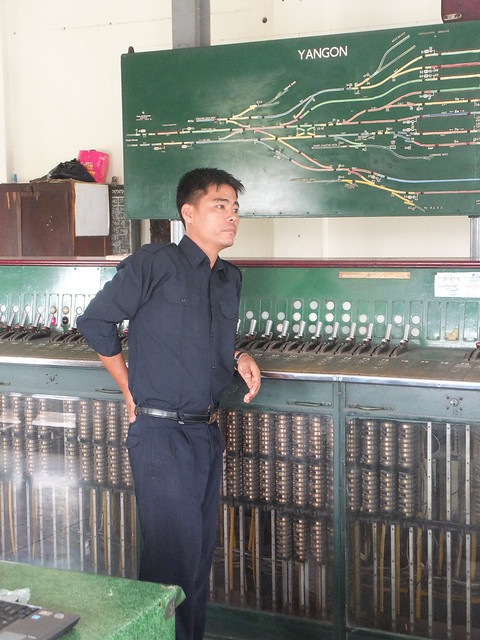
One of the young signalmen pauses by the power frame at Yangon Central Signal Box.
I could have easily spent longer here but the Station Master then casually offered a trip around the Circle Line, either on the train or in the locomotive cab. Perhaps you can guess my choice. I was invited to wait in the stationmaster's office whilst arrangements were made. I was to ride in the cab of the 13:00 clockwise Circle Line train, scheduled to complete the 32-mile round trip in 3 hours! I was conducted across to the waiting train and introduced to the friendly driver and his secondman. The locomotive was DF.1263, one of the Alstom Bo-Bo-Bo diesel electrics.
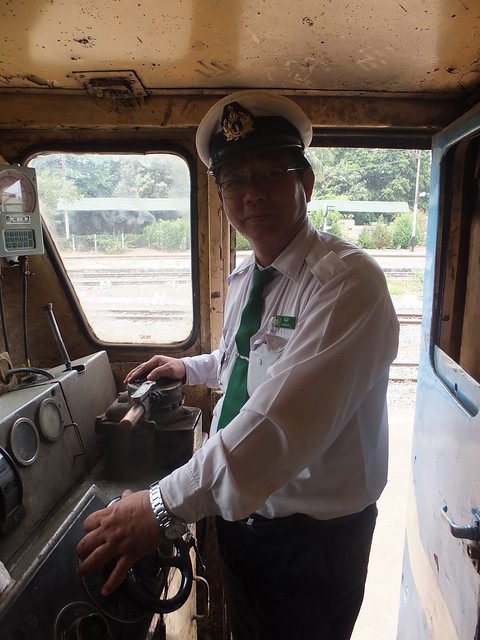 The friendly driver of DF.1263
The friendly driver of DF.1263
It had been my first trip on Yangon's Circle Line back in 2008 which got me interested in Burma's railways, so I welcomed the opportunity to repeat the trip from the vantage point of the locomotive cab.
My Pictures
Yangon Central Power Signal Box.
Cab Ride on the Circle Line, Yangon.
More
Next Post describing this trip.
Yangon Central Power Signal Box.
All my posts on Burma's Railways.
[Revised 17-May-2014]
Events of Thursday, 24th April 2014
Click on any picture below for an uncropped image.
After a second night sleeping on the floor of Ko Dut DIC, we shared breakfast with the volunteers. We said our 'goodbyes' to our friends at Ko Dut and embarked on a little sightseeing.
We drove to Thanbyuzayat which I'd first visited in 2012 (blog post here, supposedly named after the ‘tin shelter’ in the town centre which looks like a Victorian bandstand.
During the Second World War the area achieved notoriety because of the construction of the 'Death Railway'. To support the large Japanese Army which occupied Burma, the Japanese forced Commonwealth, Dutch and American prisoners of war to construct a metre gauge railway line over 400 km long connecting Siam (now Thailand) with the existing railway line through Thanbyuzayat. Work commenced late in 1942 and Thanbyuzayat became a Base Camp and Prisoner of War administration headquarters. In January 1943, a Hospital was added. Heavy prisoner casualties were also sustained during Allied bombing raids on the railway infrastructure in March and June 1943, resulting in prisoners and the sick being marched to dispersal camps along the new railway. Owing to the dreadful conditions, over 13,000 prisoners of war died during the construction, together with up to 100,000 conscripted or forced labourers from Malaya, Dutch East Indies, Siam and Burma. The railway was completed in December 1943.
After the War, graves were transferred to War Cemeteries in Chungkai and Kanchanaburi in Thailand and Thanbyuzayat in Burma. The remains of American prisoners were repatriated to the United States. We spent a few minutes at the War Cemetery at Thanbyuzayat, which has 3,149 Commonwealth and 621 Dutch graves maintained by the Commonwealth War Graves Commission. Their web page for this cemetery is here.
 Thanbyuzayat War Cemetery.
Thanbyuzayat War Cemetery.
Just south of the town, there's a commemorative plaque and a short length of track displaying what is claimed to be the first Japanese steam locomotive to run on the 'Death Railway'. In 2012, waterlogged ground made close inspection impractical but in 2014 I was able to study the rather battered locomotive. I was intrigued that bronze fittings had been replaced by wooden replicas, painted yellow.
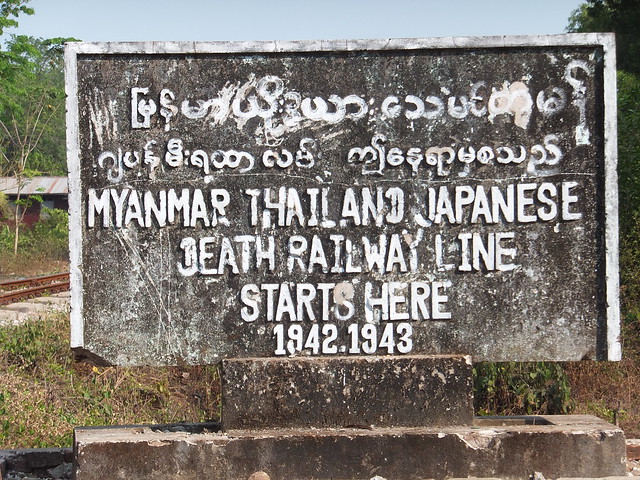 Plaque marking the end of the 'Death Railway'.
Plaque marking the end of the 'Death Railway'.
Next, we travelled west to Khaikhami Yele Paya temple built in the sea. On my earlier trip, construction of the concrete pier leading to the temples was being completed and the original wooden pier was still standing. By 2014 the old wooden pier had been removed. It was good to re-visit with the Doctor and his son.
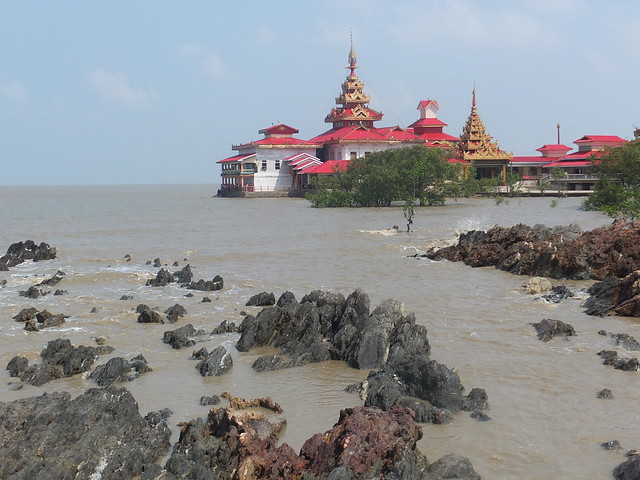 Khaikhami Yele Paya
Khaikhami Yele Paya
After visiting the temple, Doctor Hla Tun decided to purchase some fish to take back to Yangon. This involved some pretty serious discussion involving at least three of the stallholders and multiple weighings of the fish.
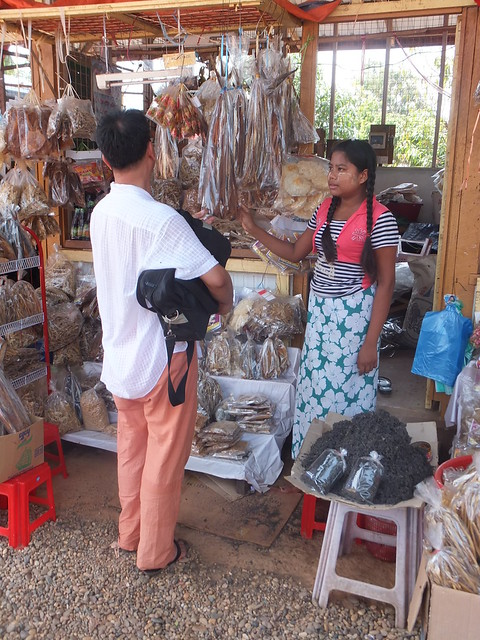
Purchasing fish.
Nearby, we visited an orphanage called 'Mirror Image' run by Sister Martha, a Catholic nun. Her English was excellent (she'd worked for 18 months in Moss Side, Manchester). Doctor Hla Tun donated medication. There were plaques crediting the assistance provided by the 'Grassroots Grant Assistance Scheme' in Japan and the Government of the Federal Republic of Germany. Three assistants were engaged in preparing monthly prescriptions of Anti Retroviral Treatment for issue to patients in their care.
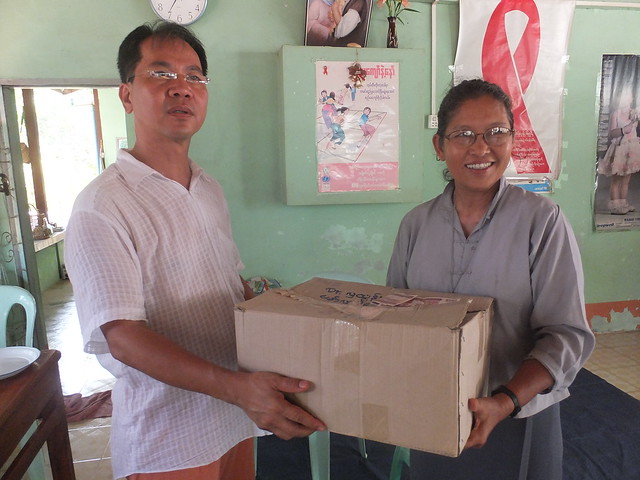 Doctor Hla Tun donates medication to Sister Martha at 'Mirror Image'.
Doctor Hla Tun donates medication to Sister Martha at 'Mirror Image'.
Finally, we detoured to the popular beach at Setse, where I was able to paddle in the Andaman Sea and enjoy fresh coconut milk with the Doctor and his Son. There were lots of people enjoying the beach but, this far from Yangon, traditional modesty prevails. A group of laughing young women running across the hot sand were dressed more for a Sunday School Outing than for the beach.
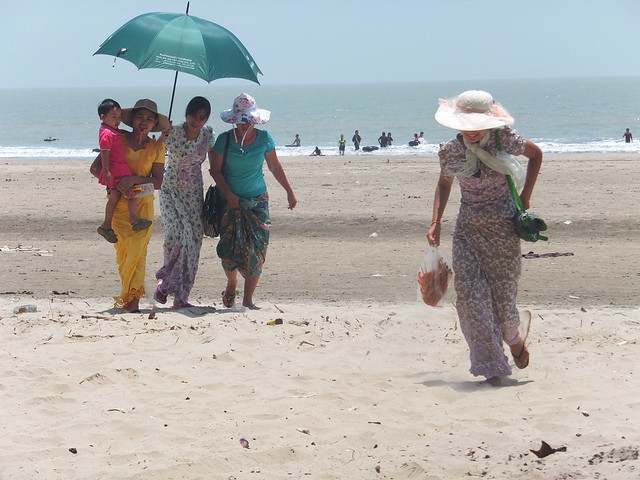 Setse Beach.
Setse Beach.
We made our way back north to Mawlamyine, pausing to buy fruit from a roadside stall. We visited two more DICs in the Mawlamyine area - Hlaing and 'Future Generation'. The population of Mawlamyine is around 300,000 and there are some decidedly poor areas.
At Hlaing, we were almost physically overwhelmed by around 400 youngsters (less than 300 had been expected). 'SKYNET' had a television cameraman and lady interviewer there and the Doctor recorded an improptu interview for them before we started the distribution. As before, there were some donations of financial assistance before the umbrellas and stationery were given out. The sheer numbers meant that the organisation did not always run smoothly but it all worked out, I think. Some rapid re-allocation had to be made of the stationery we had with us so that everybody received something on the day and the Doctor intended to send more items once he was back in Yangon.
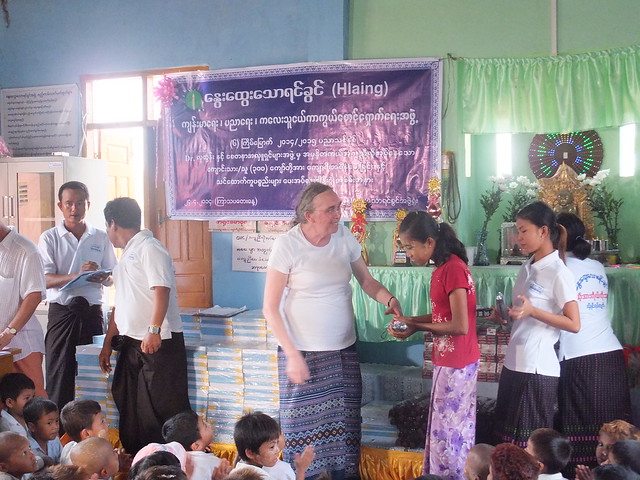 Distributions in progress at Hlaing.
Distributions in progress at Hlaing.
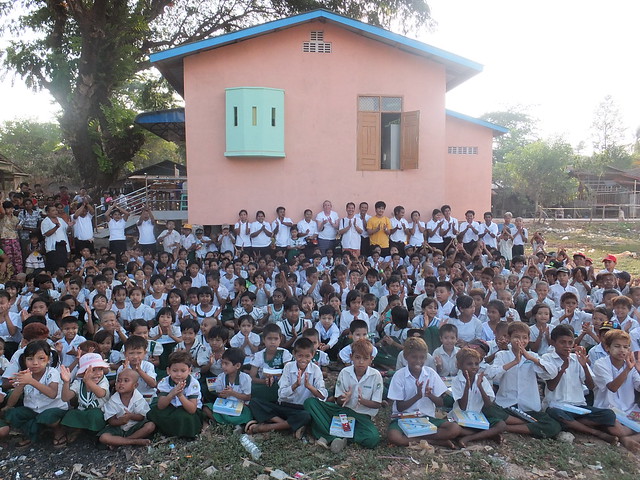 The 'Group Shot' at Hlaing.
The 'Group Shot' at Hlaing.
Our last distribution was at 'Future Generation' - a small DIC in a new building run by a charming lady. Both she and one of her assistants had computer science degrees. Once again, I was impressed by the commitment of all the volunteers who run these centres.
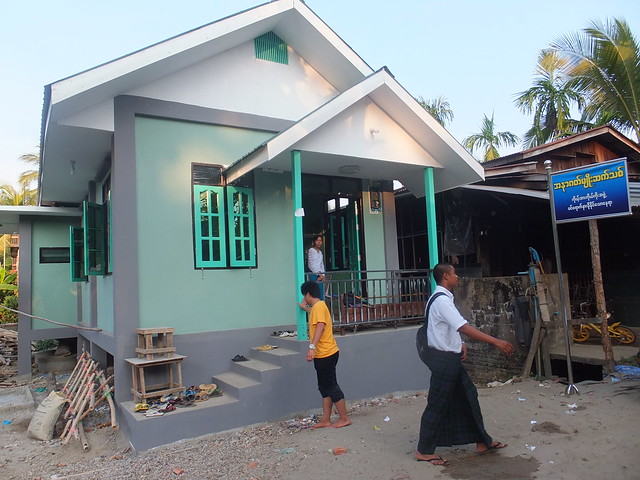 'Future Generation', Mawlamyine.
'Future Generation', Mawlamyine.
Our arrival was eagerly awaited by the young children who filled the D.I.C. and we soon completed the final distribution of our trip to Mon State.
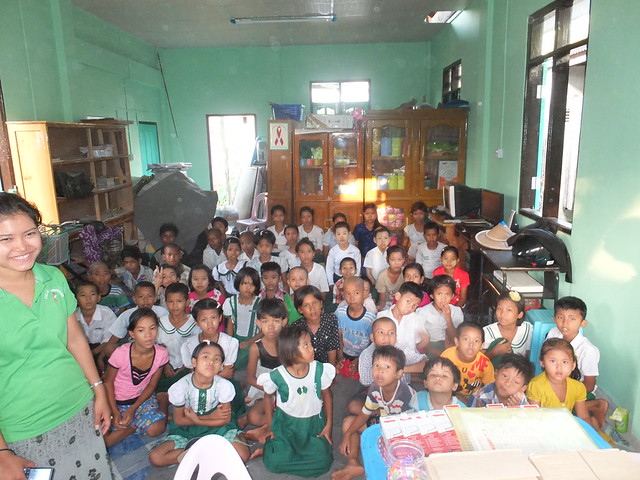 Young children eagerly awaiting the distribution at 'Future Generation'.
Young children eagerly awaiting the distribution at 'Future Generation'.
The children departed for the day and we chatted to the volunteers for a while before they, too, got ready to leave. By this time it was getting dark. We drove to the famous Strand at Mawlamyine which always takes on a holiday atmosphere at sunset. We strolled for a while amongst the happy crowds before driving to visit one of the famous hill-top temples. Finally, we drove to the P.T.T. Bus terminal in time to catch the 21:30 overnight bus to Yangon.
My Pictures
Thanbyuzayat area, Myanmar.
Khaikhami Yele Paya Shrine, Myanmar.
'Mirror Image' Orphanage.
Hlaing Drop In Centre, Mawlamyine.
'Future Generation' Drop In Centre, Mawlamyine.
Mawlamyine, Myanmar.
Mawlamyine - Yangon by Coach.
More
Next Post describing this trip.
[Revised 15-May-2014, 16-May-2014]
 The original Clinic Building, formally opened on 30th October 2011, remains in use for consultations and dispensing medication.
The original Clinic Building, formally opened on 30th October 2011, remains in use for consultations and dispensing medication.
 The New Clinic Building.
The New Clinic Building.
 Builders at work on the new Physiotherapy Unit.
Builders at work on the new Physiotherapy Unit.

 9.30 p.m. and now much quieter, but there are still patients waiting to be seen by a doctor.
9.30 p.m. and now much quieter, but there are still patients waiting to be seen by a doctor.












